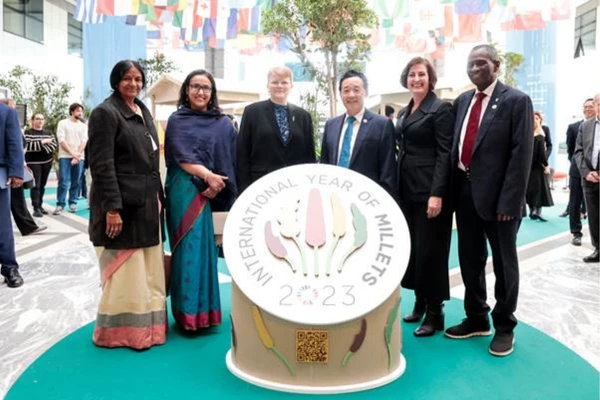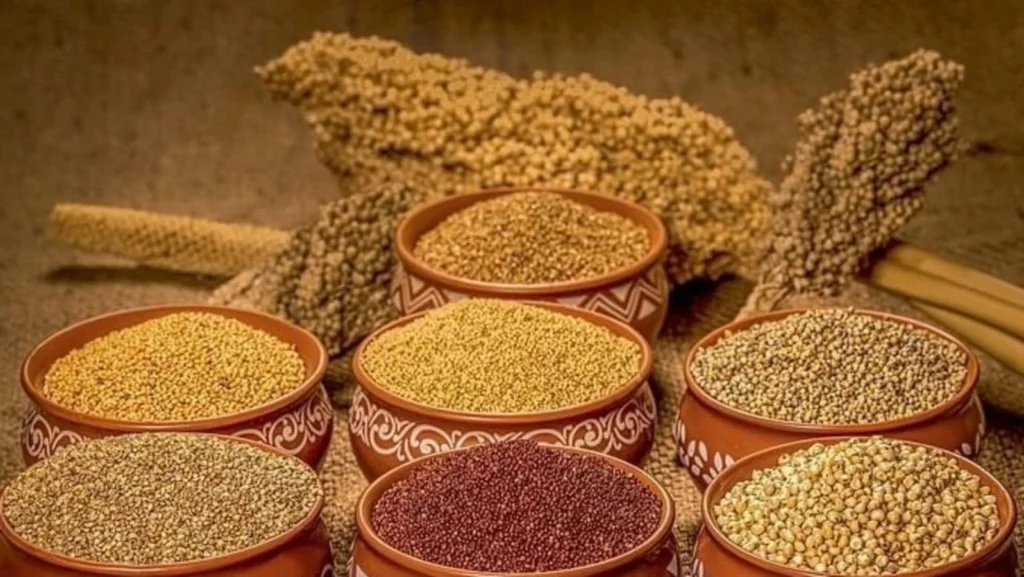International Year of Millets 2023, organized by the Food and Agriculture Organization (FAO), concluded with a grand closing ceremony at the FAO headquarters in Rome, Italy.
International Year of Millets:
- In March 2021, the United Nations General Assembly declared 2023 as the International Year of Millets, following a proposal led by India and supported by over 70 countries.
- The year-long celebration effectively raised awareness about the nutritional and health benefits of millet consumption, as well as the suitability of millets for cultivation under adverse and changing climatic conditions.
- Additionally, it highlighted the advantages of creating sustainable market opportunities for producers and consumers.
About Millets:
- Indian millets, known for their rich nutritional content and drought tolerance, are primarily cultivated in the arid and semi-arid regions of the country.
- They are small-seeded grasses belonging to the botanical family Poaceae.
- They are also known as “coarse cereals” or “cereals of the poor“.
- Indian Millets are nutritionally superior to wheat and rice as they are rich in protein, vitamins and minerals.
- They constitute an important source of food and fodder for millions of resource-poor farmers and play a vital role in ecological and economic security of India.
Benefits of Millets:
- Millets are highly adaptable to various ecological conditions, thriving in rain-fed and arid climates with minimal water, fertilizer, and pesticide requirements.
- Compared to other cereals they have superior micronutrient profile and bioactive flavonoids.
- They have a low Glycaemic Index (GI) and are associated with the prevention of diabetes.
- They are good source of minerals like iron, zinc, and calcium.
- They are gluten-free and can be consumed by celiac disease patients.
- Their consumption has a beneficial effect on managing and preventing hyperlipidemia and reducing the risk of cardiovascular diseases (CVD).
- They are found to be helpful with the reduction of weight, BMI, and high blood pressure.
- In India, millets are commonly consumed with legumes, resulting in mutual supplementation of protein, increased amino acid content, and improved overall digestibility of protein.
- They are used for dual purposes as food as well as fodder, which make it more farming efficient.
- Their cultivation helps to reduce the carbon footprint.
- Its high nutritional value, rich in fiber and essential minerals, ensures its significance as a staple food crop in the future.
Indian Millet Production Scenario:
- India is the largest producer of millet, followed by Niger and China.
- The Indian government is actively promoting millet production through its National Food Security Mission.
- Major millet-growing states in India include Rajasthan (27%), Maharashtra (15%), Uttar Pradesh (14%), Karnataka (13%), Madhya Pradesh (8%) and Gujarat (7%).
Exports:
- India is the world’s largest exporter of millet, and in 2022, it was the third largest exporter, behind Ukraine and the United States.
- India exports most of its Millet to United States, United Arab Emirates and Singapore.
Government Initiatives to Promote Shree Anna Millets:
- National Food Security Mission (NFSM) – Nutri Cereals: The Department of Agriculture and Farmers Welfare (DA&FW) is executing a Sub-Mission on Nutri-Cereals under the NFSM in 28 States & 2 Union Territories.
- This initiative offers incentives to farmers for diverse activities aimed at boosting the production and productivity of millets.
- Shree Anna Scheme: Announced in 2023, this scheme aims to popularize millets and raise their consumption.
- Eat Right campaign: The Food Safety and Standards Authority of India (FSSAI) is creating awareness to promote the use of millets as part of a healthy diet.
- Production Linked Incentive Scheme for Food Processing Industry for Millet-based products (PLISMBP): Ministry of Food Processing Industries (MoFPI) has implemented the PLISMBP during 2022-23 to 2026-27 with an outlay of Rs. 800 crores.
- Pradhan Mantri Formalization of Micro Food Processing Enterprises (PMFME) Scheme: It is launched under the Atmanirbhar Bharat Abhiyan is currently being implemented in 35 States and Union Territories (UTs).
- Poshan Abhiyan: Shree Anna (Millets) are also included under the Poshan Abhiyan of the Ministry of Women and Child Development.
- Export Promotion Forum: This forum aims to facilitate the promotion, marketing, and development of Shree Anna exports from India.
About FAO:
- The FAO is a United Nations agency that works to improve nutrition, food security, and end hunger.
- The FAO was established in Quebec City in 1945, and has 195 members, including 194 countries and the European Union.
- India has been a founding member of the Food and Agriculture Organization (FAO) since 1945.
- The FAO’s work encompasses gender equality and women’s empowerment, addressing global food security challenges, enhancing emergency responses worldwide, and advocating for sustainable land and water management.
- Reports released:
- The State of Food Security and Nutrition in the World (SOFI): This yearly report provides an overview of the number of people who are undernourished worldwide, and advocates for strategies to combat hunger and malnutrition.
- State of Food and Agriculture 2023: This report looks into the true cost of food for sustainable agrifood systems, and introduces the concept of hidden environmental, health, and social costs and benefits of agrifood systems.
- The impact of disasters on agriculture and food security: A biennial report that quantifies the losses that disasters have caused in global agriculture, and outlines strategies to reduce disaster-related risk.
Ref:source
| UPSC IAS Preparation Resources | |
| Current Affairs Analysis | Topperspedia |
| GS Shots | Simply Explained |
| Daily Flash Cards | Daily Quiz |
Frequently Asked Questions (FAQs):
What was the purpose of declaring 2023 as the International Year of Millets?
The United Nations General Assembly declared 2023 as the International Year of Millets to raise awareness about their nutritional and health benefits and their suitability for cultivation under adverse climatic conditions.
Which country led the proposal for the International Year of Millets 2023?
India led the proposal for the International Year of Millets 2023, supported by over 70 countries.
What are the benefits of consuming millets?
Millets are rich in protein, vitamins, and minerals, have a low Glycaemic Index (GI), are gluten-free, and help prevent diabetes, manage hyperlipidemia, and reduce the risk of cardiovascular diseases.
What government initiatives are in place to promote millet cultivation in India?
Initiatives include the National Food Security Mission (NFSM) – Nutri Cereals, the Shree Anna Scheme, the Eat Right campaign, the Production Linked Incentive Scheme for Food Processing Industry for Millet-based products (PLISMBP), and the Pradhan Mantri Formalization of Micro Food Processing Enterprises (PMFME) Scheme.
What reports are released by the Food and Agriculture Organization (FAO)?
The FAO releases reports such as The State of Food Security and Nutrition in the World (SOFI), State of Food and Agriculture 2023, and The impact of disasters on agriculture and food security.



